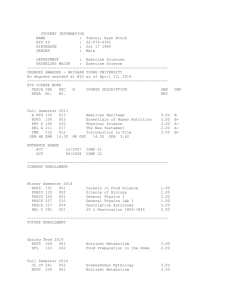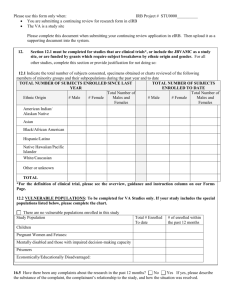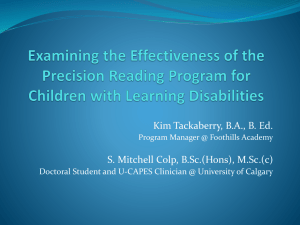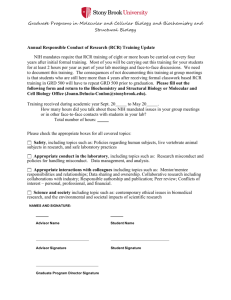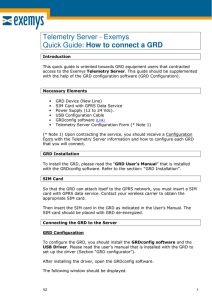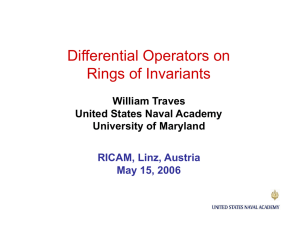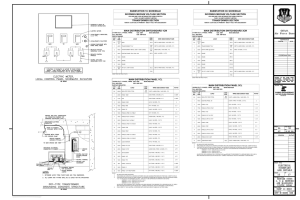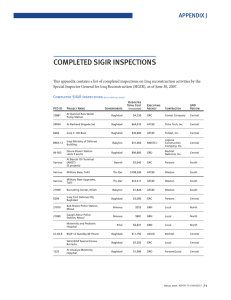Organizing Data and Information
advertisement
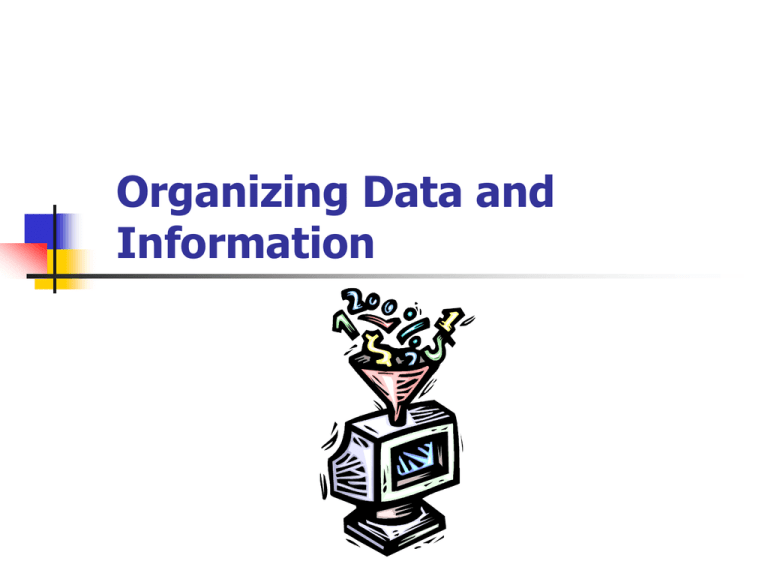
Organizing Data and Information What is Data?? Numbers, characters, images, or other method of recording, in a form which can be assessed by a human or (especially) input into a computer, stored and processed there, or transmitted on some digital channel. Data on its own has no meaning, only when interpreted by some kind of data processing system does it take on meaning and become information. People or computers can find patterns in data to perceive information, and information can be used to enhance knowledge. Since knowledge is prerequisite to wisdom, we always want more data and information. What is Data?? Database Concepts Data is a valuable resource collection of facts/figures/observations storing, organizing, retrieving, sorting, maintaining data are important activities. to organize data you must understand: Some Key Terminology FIELDS: Field Names: Each field is given a name A field is a single attribute of an entity Entity can be person, place, object, event, idea Examples: Name, Age, Salary Field Value: Specific value/content of a field name Ex.: “Joe Blow”, 30, 23000 Some Key Terminology RECORDS: Group of related field values belonging to a given entity under consideration FILE: Group of related records DATABASE: Group of related files Section 035 Fields: TCU ID 106-501-303 106-407-964 106-430-298 106-379-381 106-373-583 106-387-806 106-353-873 106-360-584 106-414-752 Preferred Josie Chris Michael Christopher Katie Cole James Emery Hilary Records Field Names: Last Benor Bosillo Buono Byars Clement Davis Day Dodson Felton Field Value: Full Name Benor,Josie Leiser Bosillo,Christopher Wayne Buono,Michael Vincent Byars,Christopher R. Clement,Katie R. Davis,Cole St.Clair Day,James Curtis Dodson,Emery Anne Felton,Hilary Schrader Grd Basis GRD GRD GRD GRD GRD GRD GRD GRD GRD Status Units Enrolled 3 Enrolled 3 Enrolled 3 Enrolled 3 Enrolled 3 Enrolled 3 Enrolled 3 Enrolled 3 Dropped 3 Data Hierarchy Database File Record Field Character Bits (0 or 1) Data Hierarchy Data Management Concerned with Data accuracy Security reliable source of data reliable data entry timeliness. protecting data to keep it from being misused or lost (authorized access, backup) Data maintenance procedures used to keep data current (adding, changing, deleting) The Traditional Approach To Data Management Limitations of Files Data Redundancy – duplicate fields in multiple files Data Inconsistency – identical fields have different data Data Isolation – inaccessibility of data from other applications Security – nonexistent Data Integrity – accuracy of data in records Database A Database - an organized collection of related data that can service many applications at the same time. A collection of data is not per se a database. Organized means that you can easily find what you want. Related means that the data have significance when viewed together. Data Entities and Attributes Entity Generalized class of people, places, or things for which data is collected, stored, and maintained Examples of entities include employees, customers, and inventory Attributes A characteristic of an entity For example, employee number, last name, first name, hire date, and department number are attributes for an employee Keys Key: A field or set of fields in a record that is used to identify the record Primary Key A field or set of fields that uniquely identifies the record Keys and Attributes The Database Approach to Data Management Advantages of Database Approach Improved strategic use of corporate data Reduced data redundancy Improved data integrity Easier modification and updating Data and program independence Better access to data and information Standardization of data access Framework for program development Better overall protection of the data Shared data and information resources Disadvantages of Database Approach Relatively high cost of purchasing and operating a DBMS in a mainframe operating environment Increased cost of specialized staff Increased vulnerability Database Models Hierarchical (tree) Network Relational Hierarchical Database Model Network Database Model Relational Database Model A Relational Database Model Link via a common field between tables Relational database and keys A relational database is a collection of tables that are related to one another based on a common field. A field, or a collection of fields, is designated as the primary key. The primary key uniquely identifies a record in the table. When the primary key of one table is represented in a second table to form a relationship, it is called a foreign key. Relating tables using a common field The primary key in the Employer table (EmployerID) is the common field that relates this table to the Position table. PositionID is the primary key in the Position table. The EmployerID field is a foreign key in this table. Primary keys can only have one occurrence in a table. Foreign keys may have multiple occurrences. Linking Database Tables to Answer an Inquiry

